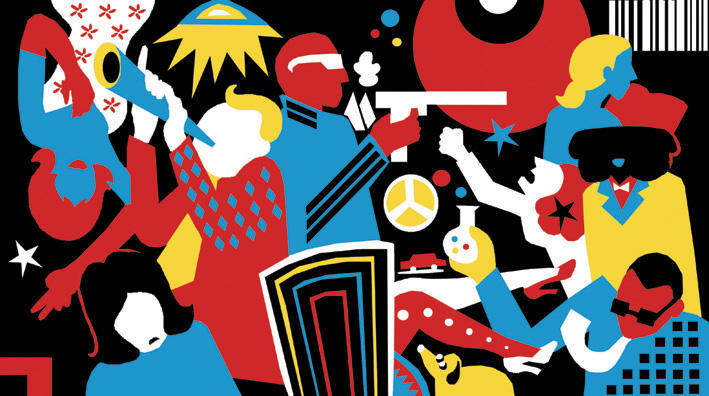
Barcelona / Valencia
West by East
Centre de Cultura Contemporània de Barcelona
May 27–September 25, 2005
Fundació Bancaixa
October 15, 2005–January 15, 2006**
While the prism of Orientalism has served as the dominant paradigm in critical examinations of relationships between East and West, a new exhibition at the CCCB offers to turn the tables, asking what East thinks of West. Curated by Paris-based poet Abdelwahab Meddeb, the show brings together nine visual artists from the East to present their views of the West. The artists’ point of departure is almost inevitably history and reflects a thoughtful consideration of context(s). Graphic artist Marjane Satrapi, for example, recreates the Arab geographer al-Idrîsî’s description of Europe in situ. Shadi Ghadirian examines the role of painting in representations of the West; Zoulikha Bouabdellah reflects upon the interesting figure of Ibn al-Munqîdh (who advocated closer relations to the West during the Crusades); Bushra Khalili takes on the taboo of “foreign love”; and Mohamed El Baz produces an installation inspired by Abraham’s sacrifice and its present-day repercussions. Hassan Musa, Khosrow Hassanzadeh, Samira Mahkmalbaf, and Touhami Ennadre each consider the loaded notion of the “war of images” — a concept that takes on meaning beyond contemporary media wars in considering Islam’s delicate relationship to iconography and visual representation at large.
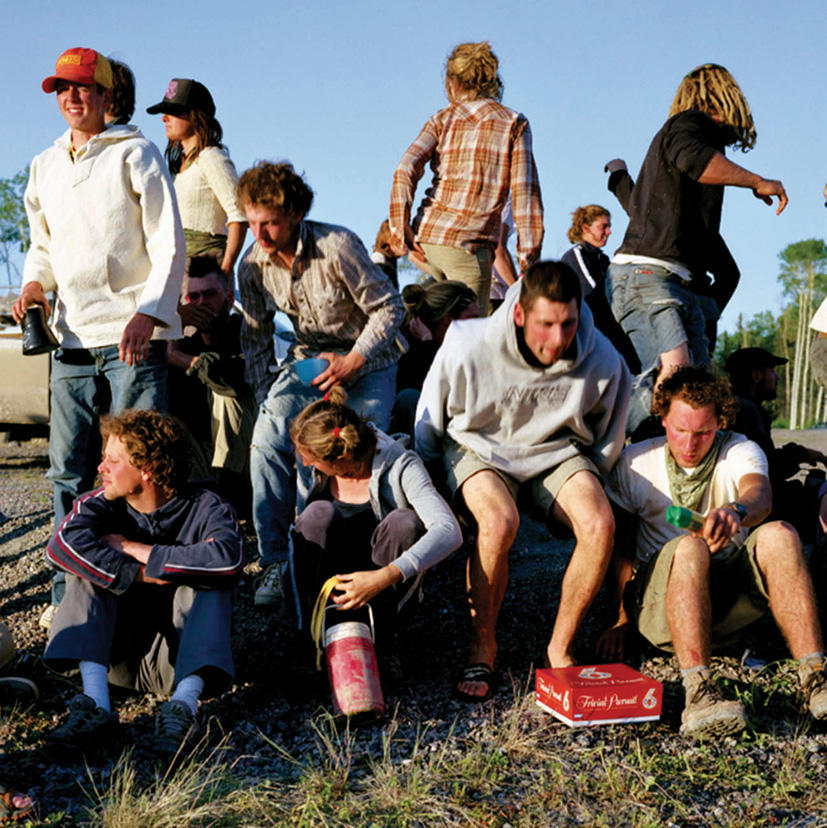
Paris
J’en Rêve
Fondation Cartier pour l’Art Contemporain
June 24–October 30, 2005
On the occasion of its twentieth anniversary, Paris’s Fondation Cartier has conceived an exhibition devoted entirely to new talent under the age of thirty. After soliciting recommendations from one hundred established international artists (including Christian Boltanski, Raymond Depardon and Nan Goldin), curators considered more than 1200 portfolios, settling in the end on fifty visual artists and forty performers who hail from India to Argentina to Thailand and beyond. For some established artists who often work with young people, such as Takashi Murakami, the nomination process was fairly straightforward, while for some the opportunity to find new work became a creative endeavor in and of itself. Congolese artist Chéri Samba, for example, organized a city-wide competition in her home town of Kinshasa.
J’en Rêve’s ambition is to reflect the development of new artistic languages and negotiate a balance between continuity and wholesale revolution in artistic practice. Not surprisingly, the theme of identity pervades these young artists’ works. If it succeeds, J’en Rêve may serve to bring new talent into the art world’s purview, something that some of the increasingly blue chip “emerging talent” shows (such as PS1’s Greater New York exhibition) have occasionally failed to do.
Some works to look out for: Argentinean Flavia Da Rin moves seamlessly between multiple mediums, producing photographs, embroidered pieces, drawings and paintings. Canadian Sarah Anne Johnson works in an ambiguous space between photography and sculpture, while Berlin-based Setareh Shahbazi (see commissioned work in Bidoun, number 4) creates a novel installation for Cartier that combines sculpture with her trademark graphic art. In the meantime, the Nomadic Nights program will feature performance and musical acts, as well as animated, short and feature-length film and video works.
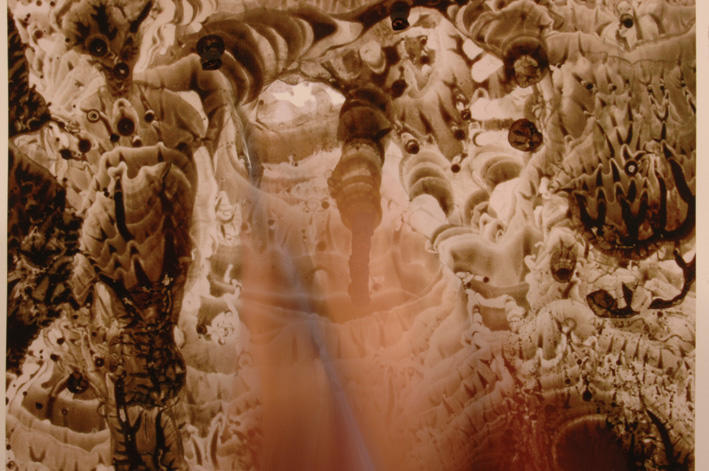
New York
Laleh Khorramian
Salon 94
September 2005
Is it possible to make art about “time, space and history,” on a scale that is less than epic? Laleh Khorramian aims for just such a balance in her first solo exhibition. Given her sweeping ambitions, the intimate scale of the New Yorkbased artist’s work can come as a surprise. Her videos are based in the monoprint process, manipulating paint on a smooth surface to generate textured backgrounds, which are then reworked by hand, and painstakingly transformed into short video animations. The tales are simple ones, like the one about Sophie, a woman walking a solitary path through theaters, crowds and wild painted forests. A detail in the surface becomes a figure, an arena or a landscape, and zooms back out again to project another scenario. The fragmented narratives build a personal universe: With the spectacle kept off just beyond the frame, emotions take center stage and the forms are suddenly very human.
Sophie and Goya, Khorramian’s first animated piece, debuted at her MFA show at Columbia in 2004. This September, the work will have a chance to be seen in a more intimate setting, against the domestic backdrop of New York’s Salon 94 gallery. The sequel to Sophie, the enigmatically titled Chopperlady sends the protagonist’s body/vessel on a journey through air. The story is further elaborated in a series of large-scale oil prints on paper, revealing how printmaking, drawing and collage inform the video pieces. By basing the work in the essentially unpredictable medium of monoprint, Khorramian constructs a brave challenge to impersonal accounts of history, spotlighting a hidden element of randomness in the smooth flow of events, and attempting to visualize time and space as it is lived and felt.
Various cities
Autumn Film Festivals
Various venues
November–December 2005
Over the last couple of years, the autumn-bound Arab film festivals have battled it out for premieres and star guests, relying variously on chic Francophonie (Marrakech), Arabian reality (Damascus), past glories (Cairo) and glitz and hard cash (Dubai). This year, thanks in part to the smooth negotiating skills of Dubai Media City’s Abdul Hamid Juma, the big boys have fallen into line, allowing particularly dedicated cinephiles the opportunity to do a post-Ramadan festival-hop around the four corners of the Middle East: Dubai has set its dates for November 5-14, Marrakech runs November 11-19, Damascus goes from November 20-27 and Cairo, November 29 to December 9.
Newcomer Ramallah (September 21-30), is set to repeat the bold formula established in its inaugural 2004 outing: international and Middle Eastern arthouse and documentary hits plus local script and directing workshops, this year overseen by Motorcycle Diaries director Walter Salles. Unfortunately, yet again, Beirut’s Mideast Film Festival has stalled — understandably, given the political hiatus there; director Colette Naufal is instead organizing Independence 05 (September 30 to October 2), a weekend of new films that focus on what’s becoming known as “the situation” — the political turmoil that has engulfed Lebanon since Rafiq Hariri’s death on February 14.
Finally, stateside, ArteEast’s CinemaEast Film Festival (Quad Cinema, New York City, November 4-10) will show its usual diverse range of Middle Eastern features, shorts and documentaries, providing an outing for films rarely seen in the US.
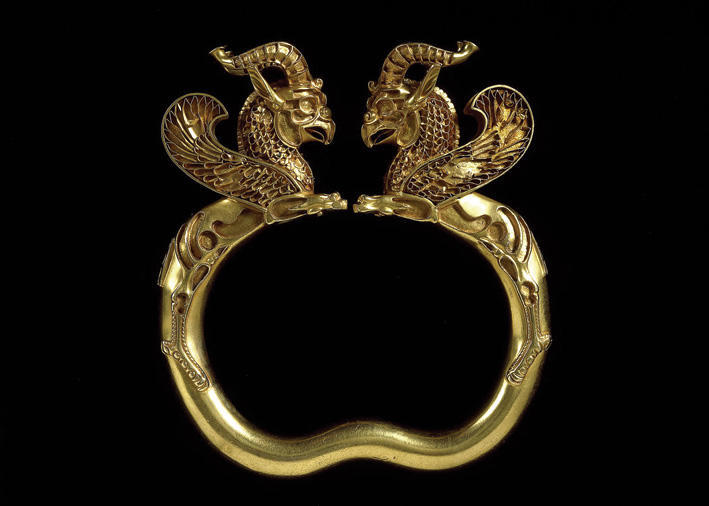
London
Forgotten Empire: The World of Ancient Persia
British Museum
September 8, 2005–January 8, 2006
After twenty-six years of living in London and feeling like the poster girl for successful integration, I recently shuddered to hear an old British friend declare that she had no idea that there was such a thing as pre-Islamic Iran. I know we are all citizens of the world now and questions of national identity are so last century, but I’ll admit I suddenly found myself possessed of that cliched Iranian national pride and held forth on the glories of ancient Persia and the empire that spanned North Africa to the Indus Valley. I railed that not to know about Persepolis and the empire that gave us a model of devolved administration, the first ever declaration of human rights, stone friezes that can be seen as a precursor to modern movies and the world’s first monotheistic religion, was as huge a cultural faux pas as not being aware of the rule of ancient Rome. Of course since we Iranians invented everything, then we must also hold our hands up for some of the empire’s less glorious achievements, but I neglected to mention that.
Luckily for me and all those other stereotypically proud Iranians frustrated by the West’s popular failure to acknowledge Iran’s contribution to civilization, this autumn the British Museum mounts the most comprehensive exhibition yet on the splendors of the ancient Persian empire. As well as drawing on the prolific collections of the Louvre and the British Museum itself, the exhibition features treasures that have never left Iran before, signifying a deepening of cultural ties despite this age of nuclear paranoia.
Istanbul
9th International Istanbul Biennial
Various venues
September 16–October 30, 2005
Following a run of portentous themes in previous years, the 9th International Istanbul Biennial narrows its focus, turning in on the city itself. Simply titled ‘Istanbul,’ the exhibition will examine the city’s urban reality, as well as its rich history and the “imaginative charge” that it represents for the world today. Since October 2004, artists, academics, writers and curators have been involved in a series of public talks, a kind of exchange program with the public in Istanbul. Given the difficulties the biennial behemoth traditionally has in engaging with its host, this move to wed the exhibition to its milieu seems wise — and given the list of mostly upcoming artists, it should make an innovative addition to the biennial canon.
In a further effort to deepen the biennial experience, curators Vasif Kortun and Charles Esche are showing multiple works by only fifty-four artists, and commissioning some to undertake long-term (three week to three month) residencies in the city. Expect new work from Phil Collins, Solmaz Shahbazi, Yael Bartana and artist group Ruangrupa, among others. Durational video, which at recent art meets has required headache-inducing hours of viewing time, is being deliberately scaled down. A hospitality zone at key venue Antrepo 5 will host guest exhibitions, including a show by young Turkish artists. Meanwhile, an intriguing project provisionally titled ‘9B Positionings’ spotlights local cultural phenomena that further the biennial’s enquiry, from lectures, catalogue essays and metaphoric maps to tours and travel advice.
The venues — with the exception of Kortun’s gallery Platform Garanti Contemporary Art Center —are all interstitial offices, warehouses and apartment blocks currently “between uses” in the Taksim-Galata area. In addition to engaging with its locale, the Biennial will also examine its relationship with the concept of “elsewhere” and the museum-as-institution via parallel projects at Esche’s base, the Van Abbe Museum in Eindhoven, Netherlands.
Cairo
Anders Als Immer: Somewhat Different
Townhouse Gallery
September 19–October 12, 2005
September will mark the arrival of one of the most ambitious design exhibitions ever to take place in Egypt. Initiated by the Stuttgart-based IFA and organized by the Goethe Institute Cairo/Alexandria, the traveling exhibition of European design will feature over ninety-five design objects, primarily of the functional variety. Importantly, the IFA has privileged the local component of the exhibition, planning in conjunction with the host Townhouse Gallery of contemporary art a series of workshops (one of which is likely to be run by legendary German light designer Ingo Maurer) and dialogues revolving around current debates in design. In the meantime, the Townhouse has initiated a competition for local designers entitled “Out of the Box” to coincide with the event. Beyond an immediate reference to “thinking outside of the box,” the competition quite literally revolves around the possibility of designing a box — an object within the confines of 30 x 30 x 30 — a lateral thinking approach of sorts. Townhouse’s Aleya Hamza will also be running a film program throughout the monthlong event. By all accounts, the IFA exhibition in its entirety is poised to contribute more to the local arts scene than the average visiting exhibition, particularly as few resources are devoted to design in Egypt.
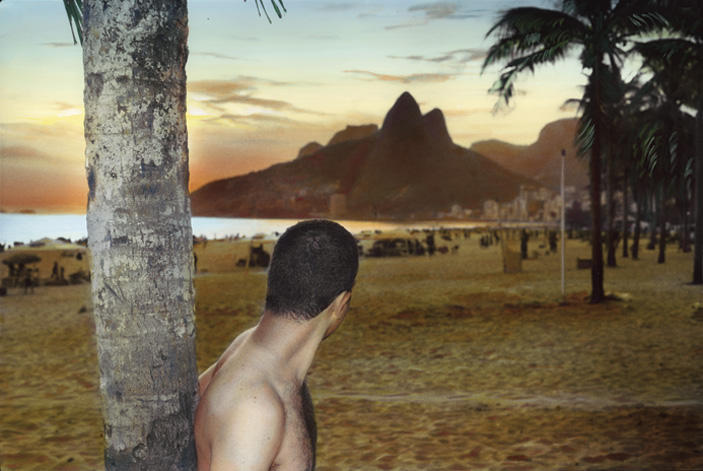
Cairo
Youssef Nabil
Townhouse Gallery
September 19–October 12, 2005
In his first exhibition in Cairo in three years, Youssef Nabil debuts a new series of works that represents a departure from his trademark portraiture. Known for his iconic representations of public figures, from Egyptian stars Youssra and Shaaban Abdel Rahim to Nan Goldin and Rossy de Palma, Nabil shifts, turning the camera increasingly on himself. Call him a modern day Gauguin. Cut to Nabil in Rio de Janeiro, Nabil in the Bois de Vincennes, Nabil in various dreamscapes — here reality is blurred and a distinct sense of romantic nostalgia is ever-present. What remains, however, is his distinctive color-tinting, a technique that harks back to the first days of portraiture and rarely fails to inject an interesting anachronistic element in the artist’s body of work.
In September Youssef Nabil will be having his first exhibition in the Gulf at Dubai’s new Third Line gallery. September 23 to October 15.
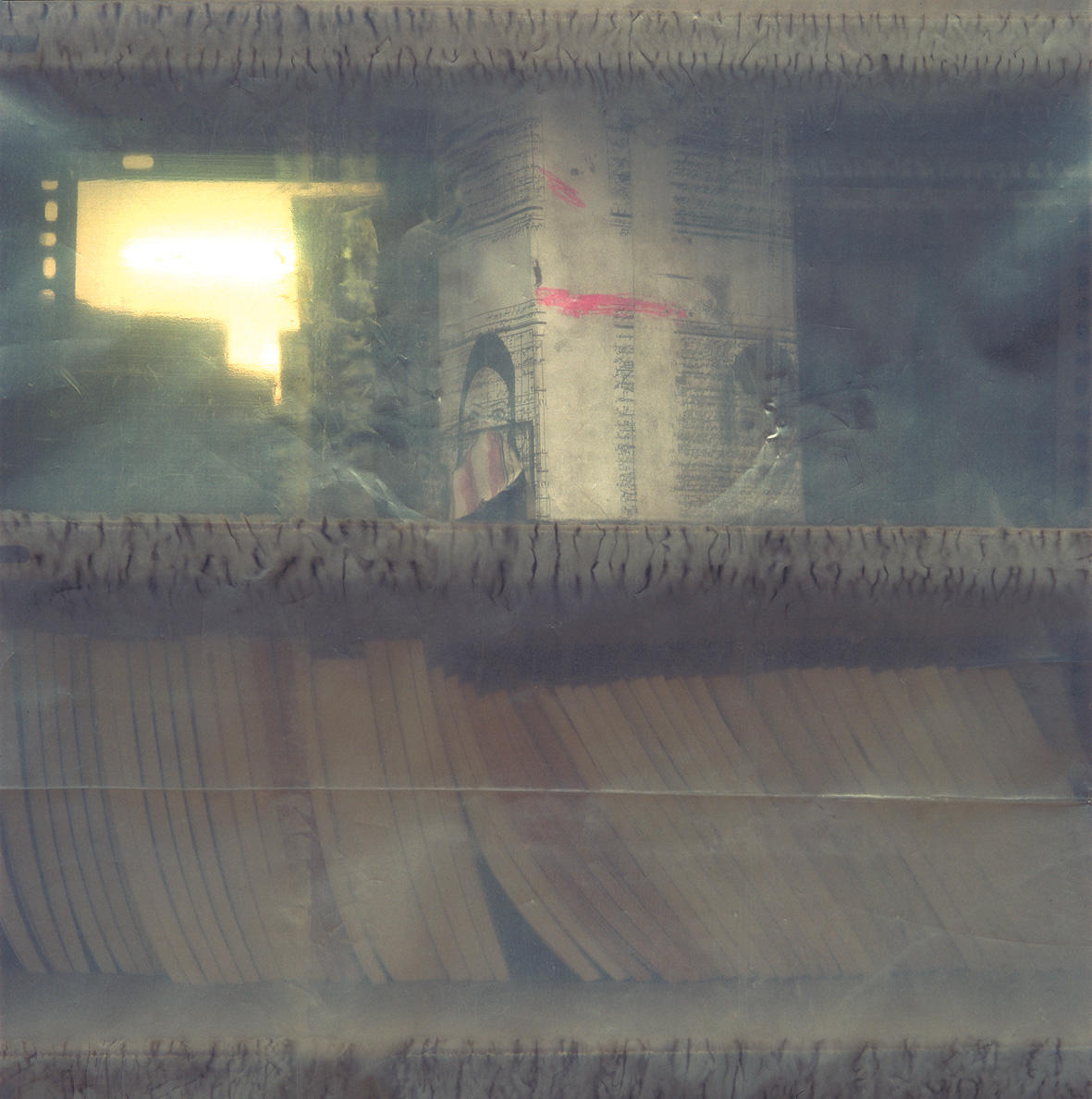
Tehran
Undistributed Packages
Silk Road Gallery
September 25–October 9, 2005
A continuation of his Undistributed Packages series, Mehran Mohajer once again explores the confrontation of disparate mediums. A bundle of half-exposed books and magazines lie in an abandoned store room, wrapped in a nonsensical shroud of papers that reference everything from Windows 2000 guidelines to antiquated etiquette texts for women. In an ambiguous state between being hidden away and coming out, the texts, wholly anonymous, lend themselves to a near-anxious state, raising questions about commodification and, finally, the power of packaging of different sorts to dictate how we consume the world around us. While Mohajer’s latest may appear at first glance a camera nostalgically poking into a dusty back closet, it has the potential to present a broader rumination on the indexical nature of images.
Algiers
Zineb Sedira
Galerie Isma
November, 2005
Zineb Sedira, the Algerian artist raised in France and based in the UK, has her first solo show in Algiers this autumn. Sedira certainly has her critics, particularly those phobic about work that references the veil or wary of practitioners that appear to be marketed in terms of their ethnicity. But after a high-profile recent solo exhibition that toured extensively in the UK, and her participation in group shows such as Africa Remix (Museum Kunst Palast, Düsseldorf; Hayward Gallery, London; Centre Georges Pompidou, Paris; Mori Museum, Tokyo) and the British Art Show 06 (Baltic, Gateshead, and touring), this is a homecoming of sorts; the show should provide a moment to reassess the artist’s work amid the culture that so often inspires it.
The show includes one of her most compelling recent works, the reflective photographic study La Maison de Ma Mère (2002), plus a new, landscape-based video piece and photographs commissioned by the Centre Culturel Français d’Alger. Sedira is currently shooting footage in Algeria; the work promises to embody her line of enquiry: “After twelve years of absence from Algeria due to the civil war, I am now able to return. The new work will be about rediscovering the land and cityscapes of Algeria, about traveling, migration and displacement,” the artist told Bidoun. “The footage will be taken from journeys by car or train in land and boat or aircraft between Marseille/Algiers, and London/Algiers, often in movement.”
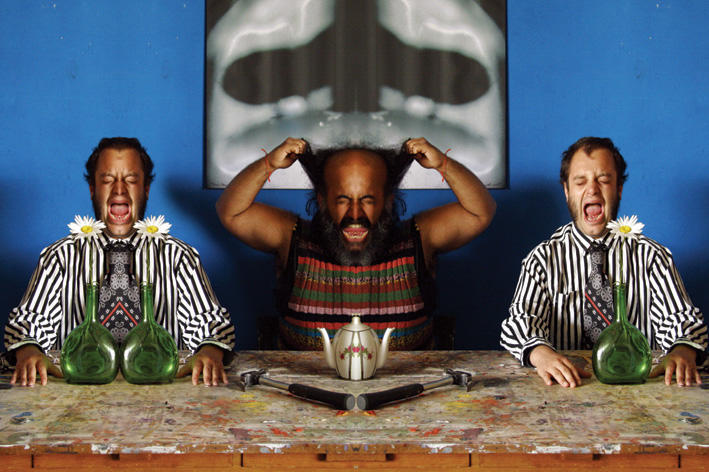
Tehran
Ramin Haerizadeh
Silk Road Gallery
November 19-30, 2005
Performing dance troupes and grotesque cabarets which toured Iran after the end of the Qajar era, in the 1920s and 1930s, are the inspiration for Ramin Haerizadeh’s new work. Haerizadeh’s camera has always had a strong feel for theater and his new series weaves in many of his old themes. His earlier series Ta’ ziyeh, part of the 2004 Barcelona show ‘Under the Veil,’ featured men in chadors and took its cue from the all-male folk theater groups that perform in honor of Imam Hossein. In this series, cross-dressing and the blurred lines between uniform and costume are further twisted by visual antics and theatrical lighting. He warps his models into pantomime figures, whimsical and freakish.
Since he started photography eleven years ago, Haerizadeh has been weaving jokes into his images but has vamped up the bittersweet humor for this exhibition. Fascinated from childhood by reflections of architecture in Persian garden pools and the phenomenon of seeing in a single frame two versions of an image, Haerizadeh continues to play with mirroring, but with more subversive results than we’ve seen before.